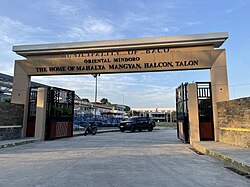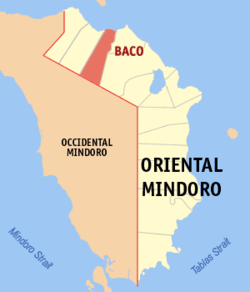
Oriental Mindoro, officially the Province of Oriental Mindoro, is a province in the Philippines located on the island of Mindoro under Mimaropa region in Luzon, about 140 kilometres (87 mi) southwest of Manila. The province is bordered by the Verde Island Passage and the rest of Batangas to the north, by Marinduque, Maestre de Campo Island, Tablas Strait and the rest of Romblon to the east, by Semirara and the rest of Caluya Islands, Antique to the south, and by Occidental Mindoro to the west. Calapan, the only city in the island, is the provincial capital and Mimaropa's regional center.

Puerto Galera, officially the Municipality of Puerto Galera, is a 1st class municipality in the province of Oriental Mindoro, Philippines. According to the 2020 census, it has a population of 41,961 people.

Mansalay, officially the Municipality of Mansalay, is a 2nd class municipality in the province of Oriental Mindoro, Philippines. According to the 2020 census, it has a population of 59,114 people.

Pinamalayan, officially the Municipality of Pinamalayan, is a 1st class municipality in the province of Oriental Mindoro, Philippines. According to the 2020 census, it has a population of 90,383 people.

Gloria, officially the Municipality of Gloria, is a 3rd class municipality in the province of Oriental Mindoro, Philippines. According to the 2020 census, it has a population of 50,496 people.

Lubang, officially the Municipality of Lubang, is a 4th class municipality in the province of Occidental Mindoro, Philippines. According to the 2020 census, it has a population of 17,437 people.

Magsaysay, officially the Municipality of Magsaysay, is a 3rd class municipality in the province of Occidental Mindoro, Philippines. According to the 2020 census, it has a population of 39,767 people.

Paluan, officially the Municipality of Paluan, is a 3rd class municipality in the province of Occidental Mindoro, Philippines. According to the 2020 census, it has a population of 18,566 people.

Sablayan, officially the Municipality of Sablayan, is a 1st class municipality in the province of Occidental Mindoro, Philippines. According to the 2020 census, it has a population of 92,598 people.

Pola, officially the Municipality of Pola, is a 3rd class municipality in the province of Oriental Mindoro, Philippines. According to the 2020 census, it has a population of 35,455 people. It is 74 kilometres (46 mi) from Calapan.

Quezon, officially the Municipality of Quezon, is a 1st class municipality in the province of Palawan, Philippines. According to the 2020 census, it has a population of 65,283 people.

Bansud, officially the Municipality of Bansud, is a 2nd class municipality in the province of Oriental Mindoro, Philippines. According to the 2020 census, it has a population of 42,671 people.

Bongabong, officially the Municipality of Bongabong, is a 1st class municipality in the province of Oriental Mindoro, Philippines. According to the 2020 census, it has a population of 76,973 people.

Bulalacao, officially the Municipality of Bulalacao, is a 3rd class municipality in the province of Oriental Mindoro, Philippines. According to the 2020 census, it has a population of 44,366 people.

Calapan, officially the City of Calapan, is a 3rd class component city in the province of Oriental Mindoro, Philippines. According to the 2020 census, it has a population of 145,786 people. The city is the capital of the province of Oriental Mindoro.

Naujan, officially the Municipality of Naujan, is a 1st class municipality in the province of Oriental Mindoro, Philippines. Its population was 109,587 at the 2020 census.

Roxas, officially the Municipality of Roxas, is a 2nd class municipality in the province of Oriental Mindoro, Philippines. It has a population of 58,849 according to the 2020 census.

San Teodoro, officially the Municipality of San Teodoro, is a 4th class municipality in the province of Oriental Mindoro, Philippines. According to the 2020 census, it has a population of 19,121 people, making it the least populated municipality in the province.

Socorro, officially the Municipality of Socorro, is a 3rd class municipality in the province of Oriental Mindoro, Philippines. According to the 2020 census, it has a population of 41,585 people.

Victoria, officially the Municipality of Victoria, is a 2nd class municipality in the province of Oriental Mindoro, Philippines. According to the 2020 census, it has a population of 52,175 people.

























